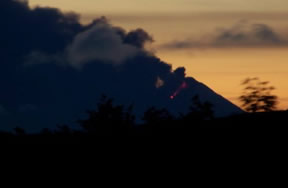
 |
Alaska volcano blasts ashSeptember 01, 2007Courtesy of Far North Science 
Photo of steam plume and incandescent lava at Pavlof, on the night of August 28, 2007, as seen from Sand Point. Although weather satellites did not detect ash, scientists at the Alaska Volcano Observatory say the presence of lightning in the plume suggests it carried gobs of the abrasive particles so dangerous to aircraft and jet engines. The evening dispatch from AVO:
The web cam - one of several the observatory trains on its misbehaving volcanoes - went active this week and can offer a startling, other-worldly glimpse of the Pacific Ring of Fire at work. Pavlof Volcano - one of the most active cones in the world - awoke Aug. 15 and began sputtering ash into the air, dribbling molten lava down its flanks and producing huge floes of mud, water and rock. The AVO continued to rate the volcano’s aircraft hazard at the Orange level and issued this statement:
By the morning of Aug. 31, the volcano had quieted. In its latest dispatch, the observatory reported that Pavlov continued to tremble, but ash had not fallen on the nearby villages Pavlov, the most hyperactive volcano in Alaska, has exploded at least 42 times since 1762 (and possibly 45 times), according to a Pavlof event timeline compiled by AVO scientists. Its dramatic snow-covered cone rises amid a cluster of other sister volcanos lurking around the Emmons Lake Volcanic Center near the tip of the Alaska Peninsula. Check out this large PDF file showing the complex and hazards.  Pavlof Volcano, on the map, is part of a chain of volcanoes running down the Alaska Peninsula and out the Aleutian Chain Credit: Seth Snedigar, Janet Schaefer, AVO/ADGGS Alaska perches along the edge of the colossal collision between immense tectonic plates, the geologic process that creates the Pacific Ring of Fire. As the Pacific plate grinds beneath the North American plate - getting squished deeper into the Earth’s mantle at about the same speed as fingernails grow - the forces and pressures generate the magma that vent to the surface in one of the world’s great chain of volcanoes. More than 100 volcanoes in Alaska have erupted sometime within the past 100 years, with 40 cones logging in blasts, spurts and explosions in historic times. Almost all of the U.S. volcanoes loom over Alaska horizons, including about 8 percent of the active volcanoes on the planet. |
|